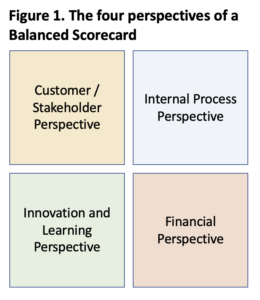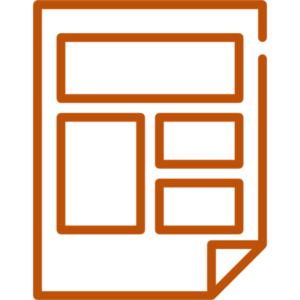![]() QUICK SUMMARY
QUICK SUMMARY
A Balanced Scorecard is a performance management tool that helps organizations ensure that their goals and corresponding metrics cover four key drivers of organizational success related to customers or other stakeholders, internal processes, innovation and learning, and finances.
![]() VIDEO OVERVIEW
VIDEO OVERVIEW
 STRATEGY DETAILS
STRATEGY DETAILS
Q1. What is a Balanced Scorecard?
 A Balanced Scorecard is an approach to deciding what types of goals and corresponding measures an organization should have and track. It's designed to help organizations ensure that they're focused on four important areas -- or or perspectives, which is the term often used -- of success and mission achievement, as shown in Figure 1:
A Balanced Scorecard is an approach to deciding what types of goals and corresponding measures an organization should have and track. It's designed to help organizations ensure that they're focused on four important areas -- or or perspectives, which is the term often used -- of success and mission achievement, as shown in Figure 1:
- The customer or stakeholder perspective: How do we look to customers and/or stakeholders? What types of outcomes are we trying to achieve?
- The internal process perspective: What must we excel at as an organization?
- The innovation and learning perspective: How do we continue to keep improving what we do?
- The financial perspective: How do we look to appropriators or funders?
In its simplest form, a Balanced Scorecard could be a single piece of paper divided into four quadrants that describes an organization's goals and metrics in the four categories. Developing the scorecard can be a valuable exercise on its own or, commonly, as part of strategic planning efforts.
Q2. Why is the Balanced Scorecard important for results-focused leaders and their organizations?
A Balanced Scorecard approach is particularly useful for leaders that want to create a broader "radar" of the building blocks of organizational success. The "balance" aspect -- having multiple perspectives -- helps determine how strong those building blocks are and whether some are getting more attention than others. For example, if your organization has typically focused more on process than outcomes, then having a customer/stakeholder perspective with the performance measures you track will be especially valuable. Or if your organization is very focused on outcomes but hasn't been as innovative as it could be -- or maybe hasn't focused as much on staff development -- then having the innovation and learning perspective will be useful.
Q3. Where does the Balanced Scorecard come from?
The framework was first introduced by Harvard Business School professor Robert Kaplan and management consultant David Norton in a 1992 article in the Harvard Business Review. The concept quickly became one of the most well-known approaches to performance management in the private sector but has since been adopted (and adapted) by many public-sector organizations as well. The rational for the Balanced Scorecard was a concern that private-sector companies were placing too much emphasis on financial indicators, without paying attention to other drivers of long-term success. Kaplan and Norton urged companies to take a more balanced approach to tracking the health of their businesses.
We've adapted their original framework to better fit public sector organizations, drawing on examples of the Balanced Scorecard's use in government. For example, in the original framework, the financial perspective asked, "How do we look to shareholders?" while the customer perspective focused solely on customers, not broader stakeholders.
Q4. What's an example of how the Balanced Scorecard was used?
In their report, Using the Balanced Scorecard: Lessons Learned from the U.S. Postal Service and the Defense Finance and Accounting Service, authors Nicholas Mathys and Kenneth Thompson describe the application of the Balanced Scorecard to these quasi-public and public agencies. As they describe, the Postal Service was aiming to strengthen their financial situation but they knew that improving customer service was a vital part of that -- and that improving customer service meant improving processes. By creating measures that spanned the Balanced Scorecard perspectives, it helped the Postal Service create a multi-pronged improvement strategy. That strategy included determining customer requirements for different types of mail customers, creating performance requirements for post masters and regional managers, and creating new incentives for staff so that different post offices saw each other as on the same team, which boosted cooperation towards achieving shared goals.
 At the core of their approach was a set of four strategic objectives, with key performance measures and targets for each, as shown in Figure 2. It's a nice example of keeping a Balanced Scorecard effort focused, using a limited set of goals and metrics. Of course, there could be -- and were -- detailed plans and metrics underneath each category, but the simplicity of the top-level Balanced Scorecard helped everyone in the organization, as well as stakeholders, know what was most important.
At the core of their approach was a set of four strategic objectives, with key performance measures and targets for each, as shown in Figure 2. It's a nice example of keeping a Balanced Scorecard effort focused, using a limited set of goals and metrics. Of course, there could be -- and were -- detailed plans and metrics underneath each category, but the simplicity of the top-level Balanced Scorecard helped everyone in the organization, as well as stakeholders, know what was most important.
Q5. How do you create a Balanced Scorecard?
The process of creating a Balanced Scorecard involves identifying a limited set of key goals and measures in each of the four categories. A useful place to start is by getting leadership input -- for example, at a workshop or leadership offsite -- in which leaders clarify their priority goals across each of the four perspectives. Then staff can help flesh out what metrics are most important for those goals and propose those back to leadership. The process of creating a Balanced Scorecard could be more or less complicated, depending on the needs of the organization. For instance, it could involve broad stakeholder input to determine customer/stakeholder needs, or process mapping to clarify internal processes. Other organizations may already have the information they need to create their first Balanced Scorecard.
In developing the scorecard, Mathys and Thompson emphasize that it is critical that organizations focus on the vital few goals and associated metrics, with no more than 15 total scorecard measures, and ideally ten. Rather than having a larger number of measures at the organization level, they suggest that sub-units develop their own Balanced Scorecards. Also note that you can modify the traditional Balanced Scorecard approach to fit your organization's needs, adjusting the perspectives or even adding more perspectives. In fact, Thompson has suggested adding a fifth perspective to the scorecard -- employee engagement -- since having employees that feel motivated and engaged are more likely to help drive customer or stakeholder outcomes.
Q6. How do you use a Balanced Scorecard once it's created?
The Balanced Scorecard can help your organization choose goals and metrics to track but it doesn't say how that information should then be used by leaders to better achieve the mission. For example, your organization might form working groups to develop initiatives or action plans to achieve the identified goals. In addition, you could also set up regular (say, monthly or quarterly) reviews with leadership to present updates on trends, progress, and action being taken to advance the goals.
 HANDOUTS / TEMPLATES
HANDOUTS / TEMPLATES
- We've created templates in Word format that you can use for a meeting or workshop with leadership around elements of a Balanced Scorecard for your organization. That includes one version that focuses on goals and measures and a more detailed second version that includes space for goals, strategies, initiatives and measures. Choosing the best template depends on how much time your brainstorming session is and what level of details seems right for the particular audience.
 ADDITIONAL RESOURCES
ADDITIONAL RESOURCES
- Article: "The Balanced Scorecard—Measures that Drive Performance" by Robert S. Kaplan and David P. Norton. Harvard Business Review. January–February 1992.
- Report: Using the Balanced Scorecard: Lessons Learned from the U.S. Postal Service and the Defense Finance and Accounting Service, by Nicholas Mathys and Kenneth Thompson. IBM Center for the Business of Government. 2006.
- Gov Innovator podcast interview: "Using the Balanced Scorecard in the public sector: An interview with Kenneth Thompson.
 CUSTOMIZED ASSISTANCE
CUSTOMIZED ASSISTANCE
Please contact us if your organization needs help in creating or implementing a Balanced Scorecard.
![]() PDF VERSION OF THIS PAGE (click here)
PDF VERSION OF THIS PAGE (click here)
